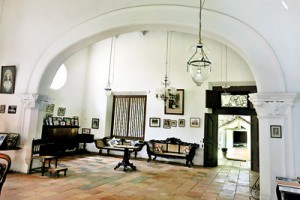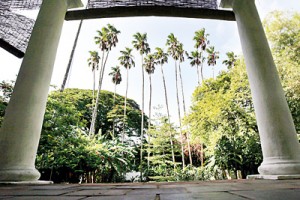Stamp from the past; architecturally and culturally
Sitting proud on Sri Lanka’s Southern coastal belt, Galle is a harmony of bustling city life and colourful tourism which is blanketed by a deep history.
Set to the background of crashing waves and salt-stung air the iconic Dutch Fort rests amidst the hubbub of the town. The juxtaposition of two different eras seamlessly woven into the same environment only adds to Galle’s appeal.
Another such monument of rich heritage is Atapattu Walawwa. It is a mere ten-minute walk away from the Fort, but we opt to drive through the town, bringing us to Lower Dickson Road.
Although it is five minutes away from the main town, the drive to the Walawwe decrescendos into the lush hum of the foliage around us and the occasional bird.
One of Galle’s stately homes, Atapattu Walawwe is a stamp from Sri Lanka’s past. When we step in through the main gates of the estate, the simple grandeur of the white washed house and sprawling lawn is reminiscent of a set from a vintage film.
We are triggered back to the present by Dr. Janaka Goonetilleke, who sits on the verandah, relaxing in a haansi putuwa (planter’s chair), decked in a bright blue not so vintage t’shirt and slacks.
Married to the current owner of the house Darshani Dias Abeyesinghe, Dr. Goonetilleke spent the last few years restoring the Walawwe to its former splendour.
The task proved to be a project extending beyond construction, requiring a thorough understanding and research into traditional Sri Lankan building techniques and traditions.

Aesthetically pleasing: The sitting room at the Walawwe. Pix by M.A. Pushpa Kumara
Dr. Goonetilleke’s efforts and research were penned in a book he released in 2012, titled “Atapattu Walawwa: Residence of the Gooneratne and Dias Abeyesinghe families of Galle.”
The gardens and house alike provide a serendipitous walk. Every nook and cranny of the well manicured lawn and surrounding trees to the black and white photographs hanging inside the house and other knick knacks have a story to tell.
Our ideal tour guide Dr. Goonetilleke acts as a narrator, his energetic anecdotes still exude a sense of wonder at the architectural prowess of the builders who worked on the estate two centuries ago.
Every stone that has been cemented, angle at which the windows were designed and even the terra cotta floors have a practical reasoning as their back story, while being perfectly in harmony with its natural surroundings.
Built by Don Bastian Gooneratne, even selecting the piece of land to build on was done after consulting a couple of Brahmins who had pointed to the middle of a stream, on which Gooneratne would erect his mansion.
Even if one’s imaginative skills do not permit it, these little discoveries all but propel you to take a second more perceptive look at the estate.
Dr Goonetilleke points out to the line of giant palms that line the front garden- a natural windbreaker to ward off the sharp sea wind. The house itself is built facing the South, “so the winds from the sea can be used,” he explains, while the natural windbreaker controls the wind speed; much like a fan.
The 1.5 acres of garden is abundant with beli, spinach, soursop and ayurvedic plants. An agro forest, the agricultural activity in the garden simultaneously preserves the productivity of the land due to the network of roots “so there is a cycle of water retention” Dr Goonetilleke says.
He doesn’t hesitate to shake his shoes off when he walks into the house and invites us too to follow suit. Although it’s a sweltering day in the making, the cool terra cotta floor is a surprising welcome, while you remember the stream that runs underground which provides the entire house with natural air conditioning.
“They also thought about the termites,” adds the Doctor. It’s why their ancestors used water absorbing mud and terra cotta floors; and lime in the walls.

Natural windbreaker: Row of giant palms in the front garden
At the entrance is a Sandakada pahana, although it lacks the elaborate drawings seen in the moonstones at the entrance of temples and ruins.
The inside is a local equivalent to an ‘Old Curiosity Shop.’
The antique chairs and tables lend a homely air to the otherwise elegant sitting room. Looking down on us through black and white canvases, the figures from a bygone time have all been residents, guests or friends of the household.
A continuing image throughout the house is a depiction of the lotus flower, its design influenced by the Buddhist Kushinara period. Symbolic of the purity of the mind, the white arch inside the house incorporates designs of the development of the lotus which, according to our guide is a greeting to the walawwe’s visitors.
Seated in the walawwe’s dining room is Karunaratne Gamage. The 70-year-old carpenter is all too familiar with the house, having worked on it alongside Dr Goonetilleke.
For veteran builders such as Gamage, traditions and customs are an integral part of the construction process. Like the builders before him, Gamage practises the custom of making a vow in favour of god Bhairava.
This custom also involves a chant, unlike those found in Pali or Sri Lankan literature. Gamage gives us a demonstration. His eyes squeezed shut and palms together; he recites the incantation he later tells us, he picked up from a master builder he apprenticed under, from Akuressa.
A resident of Galle and 6th year architecture student, Indudunu Kariyawasam grew up with stories around the Walawwe. He first visited the walawwe as a second year student, an experience he imprinted in a collection of sketches of the house.
“What I love most is the fan light inside the house,” he says. Although Galle was speckled with Portuguese buildings, the arrival of the Dutch in the 1600s’ left a more lasting effect on the city, especially in terms of architecture.
Its architectural influence lives on in the walawwe’s pillars. The addition of verandahs and courtyards were concepts introduced by the Dutch for practical purposes such as the climate, he tells us.
Indudunu’s fascination with the stately home is not unusual, given his course of study, nor is Dr. Goonetilleke’s pride and desire to preserve Sri Lanka’s building history.
The doors of the mansion have been made open to the public, its seven rooms inviting their guests to a stay reminiscent of a different era.
For details contact 2 234 189 or visit their website at www.atapattuwalawwa.com


